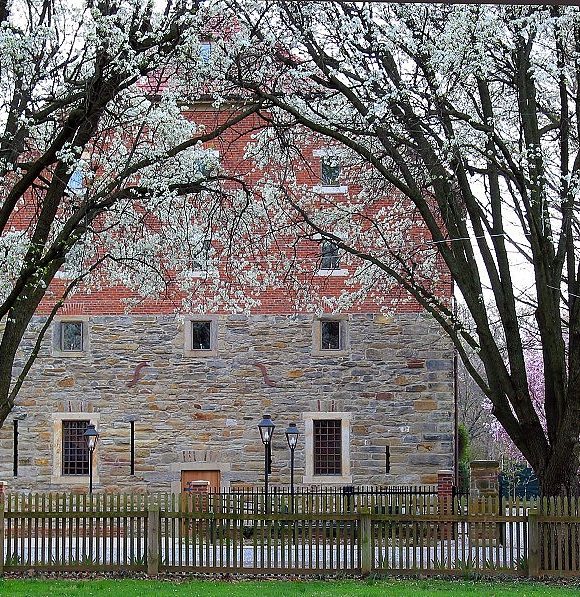
They constructed homes for families and a Community House dormitory for young single people. By 1819, the community had expanded to 20,000 acres, was composed of over 150 buildings, and had earned money from its wool carding and spinning factory, brewery, distillery, vineyards, and winery. In 1815, the remaining Pennsylvania Harmonists moved to New Harmony. The community members replaced their first log cabins with timber-framed brick buildings. The land was mostly swamp, which they drained after many of the initial settlers died from malaria. Rapp methodically planned this village, which he named “New Harmony.” First, he sent a small group of highly skilled farmers and craftsmen to establish crops, lay the grid for the village, and construct buildings. Courtesy The Indiana State Museum and Historic Sites The Harmonists built hedge labyrinths in their communities to symbolize their spiritual journey. While the Harmonists’ village was successful, outsiders were suspicious, so Rapp decided to relocate his group farther west-to 3,500 acres in southern Indiana alongside the Wabash River-where he had room to grow and his followers could live without hostile neighbors. “They’re interested in becoming self-sufficient, prosperous communities.” “Even though the Rappites are separating themselves in society, they’re eager to learn new technology, new production techniques,” Koerber explains. The Harmonists were also economically successful as a group. Their textiles and woolens were highly sought-after goods. They were hardworking, industrious, and skilled in manufacturing, construction, and agriculture. and outlined the community’s rules, like holding all property in common and guaranteeing a lifetime of care to members.īy 1814, the Harmonists grew to 700 members and had constructed 130 buildings, including factories, an inn, a tannery, a brewery, schools, a labyrinth, houses, and more. In 1805, they established the Harmony Society by signing articles of association that formally established their group in the U.S. They bought 3,000 acres of land outside of Pittsburgh and named their colony Harmony. Seeking freedom from religious persecution in Lutheran Germany, the Harmonists arrived in Pennsylvania in 1803. “The religious separatists who want to create a more perfect society, led by a charismatic leader, that’s the Rappites,” says Susannah Koerber, chief curator and research officer of the Indiana State Museum and Historic Sites. They practiced a branch of Christianity known as perfectionism-the same belief system that inspired the Oneida Community of John Humphrey Noyes-and aspired to lead a morally upstanding, sin-free life that would eventually grant them entry to Christ’s kingdom. Led by Johann Georg Rapp, the Harmonists believed that the second coming of Christ would occur during their lifetimes. New Harmony’s story begins in Germany, with a religious group called the Harmony Society, or the Rappites. Courtesy the Indiana State Museum and Historic Sites The question remains: Can New Harmony thrive while retaining a connection to its utopian roots? The Harmonists were skilled builders and constructed architecture that still stands today, including this Granary building, which is now used for events.

Flower came to the community not as a tourist, but to scout the area with the goal of recruiting performing artists to live and work there. While these experimental communities failed, some of their utopian philosophies are still very much alive among New Harmony’s present-day artistic patrons.īut like many small towns, New Harmony is also experiencing depopulation.

First, religious separatists who dedicated their lives to God and preparations for the second coming of Christ, then secular reformers who believed a society based on equality and intellectual pursuits would lead to a better world for everyone. New Harmony is a hotbed for utopians.įrom the early 19th century until today, New Harmony has attracted people who go against society’s grain.

And then there’s the hedge labyrinth and roofless church-hints that this isn’t just any ordinary rural community. There are trees and flowers everywhere, and plaques reminding you that it’s a historic site. It has a main street lined with historic brick buildings, some painted in lively colors like San Francisco’s Victorians. The small town, located near Indiana’s southernmost tip, is not unlike many American towns. “When people, including me, come here, they talk about it like it’s a magical place.” “I felt like I was in Alice in Wonderland,” she says. When Melissa Flower, a theater director, visited New Harmony, Indiana, for the first time earlier this year, she thought she’d stepped through the looking glass.


 0 kommentar(er)
0 kommentar(er)
